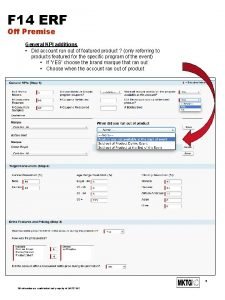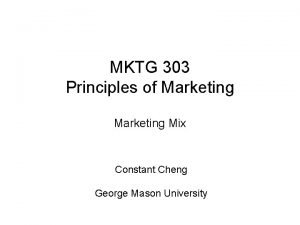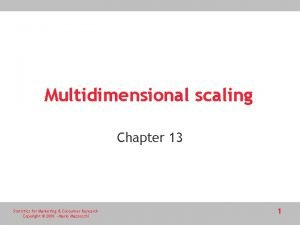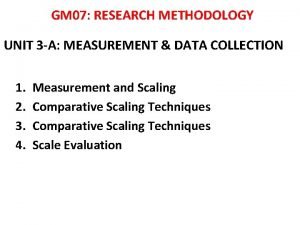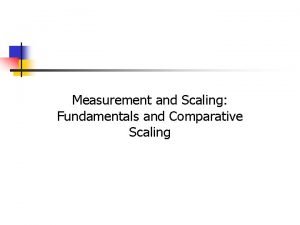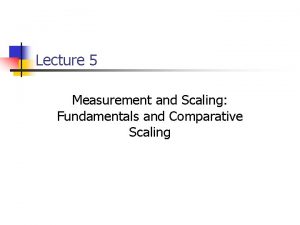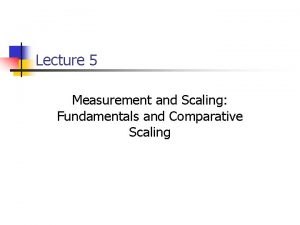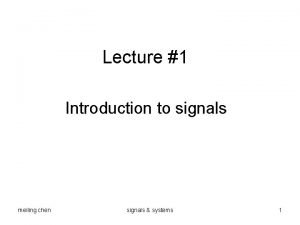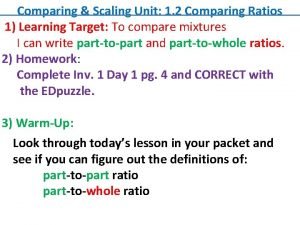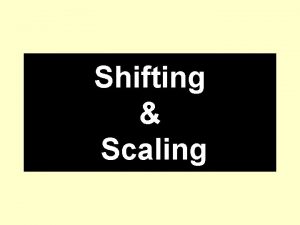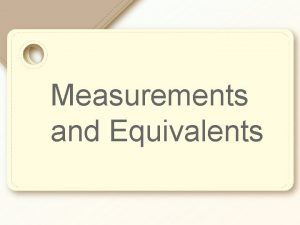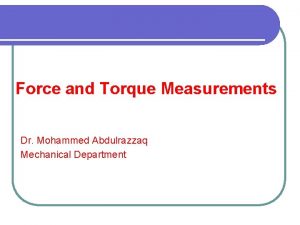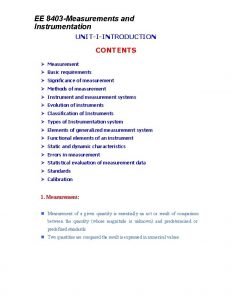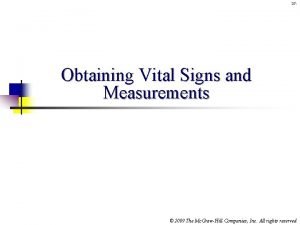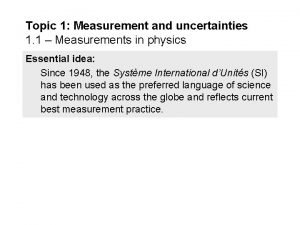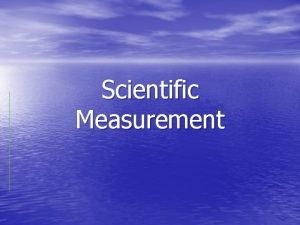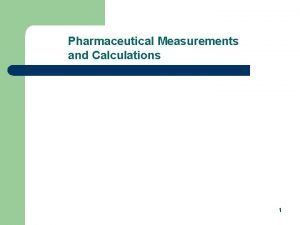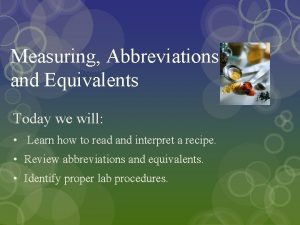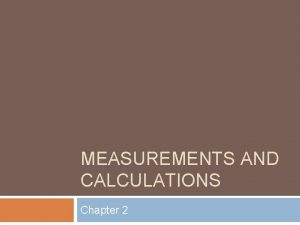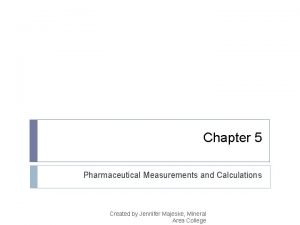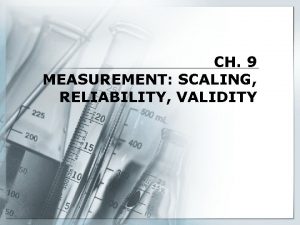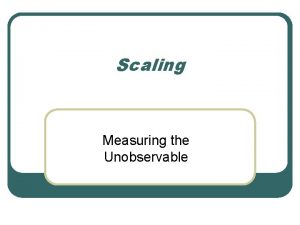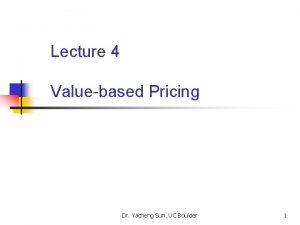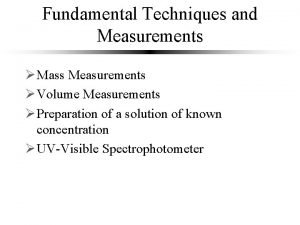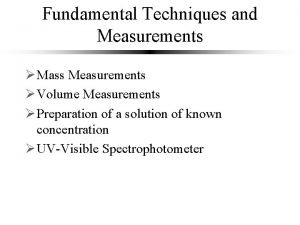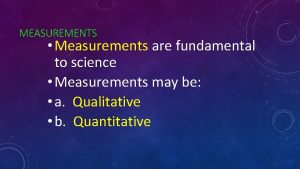Measurements and Scaling MKTG 3350 MARKETING RESEARCH Yacheng
















































- Slides: 48

Measurements and Scaling MKTG 3350: MARKETING RESEARCH Yacheng Sun Leeds School of Business Dr. Yacheng Sun, UC Boulder 1

Today’s Agenda • Measurement and Scaling • Types of Ratings Scales • Accuracy of Measurement 2

Table 10. 3 Some Commonly Used Scales in Marketing Construct Scale Descriptors Attitude Very Bad, Neither Bad nor Good, Very Good Importance Not at All Important, Not Important, Neutral, Important, Very Important Satisfaction Very Dissatisfied, Neither Dissatisfied nor Satisfied, Very Satisfied Purchase Frequency Never, Rarely, Sometimes, Often, Very Often 3

Measurement and Scaling Measurement means assigning numbers or other symbols to characteristics of objects according to certain pre-specified rules. – One-to-one correspondence between the numbers and the characteristics being measured. – The rules for assigning numbers should be standardized and applied uniformly. – Rules must not change over objects or time. 4

Measurement and Scaling (Cont. ) Scaling involves creating a continuum upon which measured objects are located. Consider an attitude scale from 1 to 100. Each respondent is assigned a number from 1 to 100, with 1 = Extremely Unfavorable, and 100 = Extremely Favorable. Measurement is the actual assignment of a number from 1 to 100 to each respondent. Scaling is the process of placing the respondents on a continuum with respect to their attitude toward department stores. 5

Scale Characteristics Description Unique labels or descriptors that are used to designate each value of the scale. Order Relative sizes or positions of the descriptors. Distance Absolute differences between the scale descriptors may be expressed in units. Origin Scale has a unique or fixed beginning or true zero point. 6

Figure 9. 3 Primary Scales of Measurement Primary Scales Nominal Scale Ratio Scale Ordinal Scale Interval Scale 7

Nominal/Categorical Data • • Zip code of residence Employment status Marital status Gender Race Religion Ethnicity 8

Interval Data 9

10

11

Take measurements at highest level Measure can’t exceed basic nature of attribute e. g. , taste 12

13

Permissible Statistics 14

Descriptive Statistics for Different Scale Types 15

Figure 9. 5 A Classification of Scaling Techniques Noncomparative Scales Comparative Scales Paired Comparison Constant Sum Continuous Rating Scales Itemized Rating Scales Rank Order Likert Stapel Semantic Differential 16

Comparative Scaling Techniques 17

A Comparison of Scaling Techniques Comparative scales involve the direct comparison of stimulus objects. Comparative scale data must be interpreted in relative terms and have only ordinal or rank order properties. In noncomparative scales, each object is scaled independently of the others in the stimulus set. The resulting data are generally assumed to be interval or ratio scaled. 18

Comparative Scaling Techniques Paired Comparison Scaling • A respondent is presented with two objects and asked to select one according to some criterion. • The data obtained are ordinal in nature. • Paired comparison scaling is the most widely used comparative scaling technique. • With n brands, [n(n - 1) /2] paired comparisons are required. • Under the assumption of transitivity, it is possible to convert paired comparison data to a rank order. 19

Figure 9. 6 Paired Comparison Scaling Instructions We are going to present you with ten pairs of shampoo brands. For each pair, please indicate which one of the two brands of shampoo in the pair you would prefer for personal use. Recording Form Jhirmack Finesse Vidal Sassoon Head & Shoulders Pert Number of times preferred Finesse Vidal Sassoon 0 0 0 Head & Shoulders Pert 1 1 0 0 1 1 0 1 A 1 1 0 1 0 0 1 3 B 2 0 4 1 A A 1 in a particular box means that the brand in that column was preferred over the brand in the corresponding row. A 0 means that the row brand was preferred over the column brand. B The number of times a brand was preferred is obtained by summing the 1 s in each column. 20

Figure 9. 7 Rank Order Scaling Instructions Rank the various brands of toothpaste in order of preference. Begin by picking out the one brand that you like most and assign it a number 1. Then find the second most preferredbrand assign it a number 2. Continue this procedure until you have ranked all the brands of toothpaste in order of preference. The least preferred brand should be assigned a a rank of 10. No two brands should receive the same rank number. The criteria of preference is entirely up to you. There is no right or wrong answer— Just try to be consistent. Brand Rank Order 1. Crest 2. Colgate 3. Aim 4. Mentadent 5. Macleans 6. Ultra Brite 7. Close Up 8. Pepsodent 9. Plus White 10. Stripe 21

Comparative Scaling Techniques Constant Sum Scaling • Respondents allocate a constant sum of units, such as 100 points, to attributes of a product to reflect their importance. • If an attribute is unimportant, the respondent assigns it zero points. • If an attribute is twice as important as some other attribute, it receives twice as many points. • The sum of all the points is 100. Hence, the name of the scale. 22

Figure 9. 8 Constant Sum Scaling Instructions Below are eight attributes of bathing soaps. Please allocate 100 points among the attributes so that your allocation reflects the relative importance you attach to each attribute. The more points an attribute receives, the more important the attribute is. If an attribute is not at all important, assign it zero points. If an attribute is twice as important as some other attribute, it should receive twice as many points. Form AVERAGE RESPONSES OF THREE SEGMENTS Attribute Segment III 1. Mildness 8 2 4 2. Lather 2 4 17 3. Shrinkage 3 9 7 4. Price 53 17 9 5. Fragrance 9 0 19 6. Packaging 7 5 9 7. Moisturizing 5 3 20 8. Cleaning Power 13 60 15 Sum 100 100 23

Relative Advantages of Comparative Scales • Small differences between stimulus objects can be detected. • Same known reference points for all respondents. • Easily understood and can be applied. • Involve fewer theoretical assumptions. • Tend to reduce halo or carryover effects from one judgment to another. 24

Relative Disadvantages of Comparative Scales • Ordinal nature of the data. • Inability to generalize beyond the stimulus objects scaled. 25

Noncomparative Scaling Techniques 26

Noncomparative Scaling Techniques • Respondents evaluate only one object at a time, and for this reason noncomparative scales are often referred to as monadic scales. • Noncomparative techniques consist of continuous and itemized rating scales. 27

Figure 10. 3 A Classification of Noncomparative Rating Scales Continuous Rating Scales Semantic Differential Itemized Rating Scales Stapel Likert 28

Continuous Rating Scale Respondents rate the objects by placing a mark at the appropriate position on a line that runs from one extreme of the criterion variable to the other. The form of the continuous scale may vary considerably. How would you rate Sears as a department store? Version 1 Probably the worst - - - -I - - - - - - - - - - Probably the best Version 2 Probably the worst - - - -I - - - - - - - - -- - Probably the best 0 10 20 30 40 50 60 70 80 90 Version 3 Very bad Neither good Very good nor bad Probably the worst - - - -I - - - - - -- - - - -Probably the best 0 10 20 30 40 50 60 70 80 90 100 29

Itemized Rating Scales • The respondents are provided with a scale that has a number or brief description associated with each category. • The categories are ordered in terms of scale position, and the respondents are required to select the specified category that best describes the object being rated. • The commonly used itemized rating scales are the Likert, semantic differential, and Stapel scales. 30

Likert Scale The Likert scale requires the respondents to indicate a degree of agreement or disagreement with each of a series of statements about the stimulus objects. 1. Sears sells high quality merchandise. 2. Sears has poor in-store service. 3. I like to shop at Sears. Strongly disagree Disagree Neither Agree agree nor disagree Strongly agree 1 2 X 3 4 5 1 2 3 X 4 5 • The analysis can be conducted on an item-by-item basis (profile analysis), or a total (summated) score can be calculated. • When arriving at a total score, the categories assigned to the negative statements by the respondents should be scored by reversing the scale. 31

Semantic Differential Scale The semantic differential is a seven-point rating scale with end points associated with bipolar labels that have semantic meaning. SEARS is: Powerful --: --: -X-: --: Weak Unreliable --: --: --: -X-: --: Reliable Modern --: --: --: -X-: Old-fashioned • The negative adjective or phrase sometimes appears at the left side of the scale and sometimes at the right. • This controls the tendency of some respondents, particularly those with very positive or very negative attitudes, to mark the right- or left-hand sides without reading the labels. • Individual items on a semantic differential scale may be scored on either a -3 to +3 or a 1 to 7 scale. 32

Stapel Scale The Stapel scale is a unipolar rating scale with ten categories numbered from -5 to +5, without a neutral point (zero). This scale is usually presented vertically. SEARS +5 +4 +3 +2 +1 HIGH QUALITY -1 -2 -3 -4 X -5 +5 +4 +3 +2 X +1 POOR SERVICE -1 -2 -3 -4 -5 The data obtained by using a Stapel scale can be analyzed in the same way as semantic differential data. 33

Table 10. 1 Basic Noncomparative Scales Scale Basic Characteristics Examples Advantages Disadvantages Continuous Rating Scale Place a mark on a continuous line Reaction to TV commercials Easy to construct Scoring can be cumbersome unless computerized Likert Scale Degree of agreement on a 1 (strongly disagree) to 5 (strongly agree) scale Measurement of Easy to attitudes construct, administer, and understand More time consuming Semantic Differential Seven-point scale with bipolar labels Brand, product, and company images Difficult to construct bipolar adjectives Stapel Scale Unipolar ten-point Measurement of Easy to scale, -5 to +5, without attitudes and construct and a neutral point (zero) images administer over telephone Itemized Rating Scales Versatile Confusing and difficult to apply 34

Table 10. 2 Summary of Itemized Rating Scale Decisions 1. Number of categories While there is no single, optimal number, traditional guidelines suggest that there should be between five and nine categories. 2. Balanced vs. unbalanced In general, the scale should be balanced to obtain objective data. 3. Odd or even number of Categories If a neutral or indifferent scale response is possible for at least some of the respondents, an odd number of categories should be used. 35

Table 10. 2 (Cont. ) Summary of Itemized Rating Scale Decisions 4. Forced versus nonforced In situations where the respondents are expected to have no opinion, the accuracy of data may be improved by a nonforced scale. 5. Verbal description An argument can be made for labeling all or many scale categories. The category descriptions should be located as close to the response categories as possible. 6. Physical form A number of options should be tried and the best one selected. 36

Figure 10. 4 Balanced and Unbalanced Scales Balanced Scale Unbalanced Scale Surfing the Internet is ____ Extremely Good ____ Very Good ____ Bad ____ Somewhat Good ____ Very Bad ____ Extremely Bad ____ Very Bad 37

Figure 10. 5 Rating Scale Configurations A variety of scale configurations may be employed to measure the comfort of Nike shoes. Some examples include: Nike shoes are: 1) Place an “X” on one of the blank spaces… Very Uncomfortable Very Comfortable 2) Circle the number… Very 1 Uncomfortable 2 3 4 5 6 7 Very Comfortable 3) Place an “X” on one of the blank spaces… Very Uncomfortable Neither Uncomfortable nor Comfortable Very Comfortable 38

Figure 10. 5 Rating Scale Configurations (Cont. ) 4) Uncomfortable Somewhat Comfortable Very Neither Very Uncomfortable Comfortable Uncomfortable nor Uncomfortable 5) -3 Very Uncomfortable -2 -1 0 Neither Comfortable nor Uncomfortable 1 2 3 Very Comfortable 39

Some Unique Rating Scale Configurations Thermometer Scale Instructions: Please indicate how much you like Mc. Donald’s hamburgers by coloring in thermometer. Start at the bottom and color up to the temperature level that best indicates how strong your preference is. Form: Like very much 100 75 50 25 0 Dislike very much Smiling Face Scale Instructions: Please point to the face that shows how much you like the Barbie Doll. If you do not like the Barbie Doll at all, you would point to Face 1. If you liked it very much, you would point to Face 5. Form: 1 2 3 4 5 40

Reliability and Validity 41

Sources of Measurement Differences M=A+E where: M = measurement A = true indicator E = random or systematic error 42

Reliability Degree to which measures are free from random error and therefore yield consistent results 43

44

Validity versus Reliability Validity Reliability 45

Rulers are Reliable and Valid 46

47

Relationship Between Reliability and Validity • If a measure is perfectly valid, it is also perfectly reliable. In this case, there is no random or systematic error. • If a measure is unreliable, it cannot be perfectly valid, since at a minimum random error is present. Thus, unreliability implies invalidity. • If a measure is perfectly reliable, it may or may not be perfectly valid, because systematic error may still be present. • Reliability is a necessary, but not sufficient, condition for validity. 48
 Cs 3350
Cs 3350 Mktg 12 principles of marketing
Mktg 12 principles of marketing Principles of marketing chapter 1
Principles of marketing chapter 1 Yacheng sun
Yacheng sun Qualitative research procedures
Qualitative research procedures Undifferentiated targeting strategy
Undifferentiated targeting strategy Diageo emc
Diageo emc Mktg 12th edition
Mktg 12th edition Sports entertainment definition
Sports entertainment definition Constant cheng
Constant cheng Mktg 10
Mktg 10 Multidimensional scaling in marketing
Multidimensional scaling in marketing Example of constant sum scale
Example of constant sum scale Marketing information systems and marketing research
Marketing information systems and marketing research Marketing information systems and marketing research
Marketing information systems and marketing research Define marketing information management
Define marketing information management Marketing information systems and marketing research
Marketing information systems and marketing research Marketing information systems and marketing research
Marketing information systems and marketing research Marketing information systems and marketing research
Marketing information systems and marketing research Problem definition in research
Problem definition in research Scales of measurement
Scales of measurement Manoj kuamr
Manoj kuamr Scales of measurement
Scales of measurement What is comparative scale
What is comparative scale Chen
Chen Measurement and scaling
Measurement and scaling Outsystems ui patterns
Outsystems ui patterns Shifting and scaling functions
Shifting and scaling functions Comparing and scaling unit test
Comparing and scaling unit test Shifting and scaling functions
Shifting and scaling functions Gracey curette classification
Gracey curette classification Measurements equivalents and adjustments
Measurements equivalents and adjustments Chapter 2 measurements and calculations
Chapter 2 measurements and calculations Force and torque measurements
Force and torque measurements Ee8403 measurements and instrumentation
Ee8403 measurements and instrumentation Temperature is an anthropometric measurement
Temperature is an anthropometric measurement Chapter 37 vital signs and measurements
Chapter 37 vital signs and measurements Segment lengths in circles
Segment lengths in circles Body measurements and vital signs chapter 36
Body measurements and vital signs chapter 36 Vital signs and anthropometric measurements:
Vital signs and anthropometric measurements: Measurements and uncertainties ib physics
Measurements and uncertainties ib physics Scientific measurements
Scientific measurements Pharmaceutical measurements and calculations
Pharmaceutical measurements and calculations Metrology and measurements subject code
Metrology and measurements subject code Metrology and measurements subject code
Metrology and measurements subject code Abbreviation and equivalents of measurements
Abbreviation and equivalents of measurements Percent error example
Percent error example Pharmaceutical measurements and calculations
Pharmaceutical measurements and calculations Derived quantities
Derived quantities






